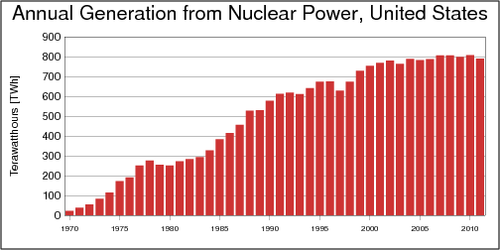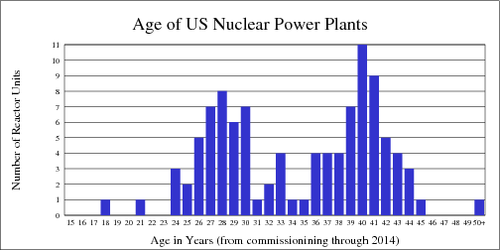Would you drive a 50-year old car to work every day? A car without seat belts, air bags, catalytic converter, and Bluetooth to stream your favourite songs from your iPod or iPhone? Would you trust that car to keep you safe in an accident? If you answered no, then what technological equipment would you use comfortably that is 50 years old? Your 50-year old vacuum cleaner? Your 50-year old refrigerator. But wait: what about your 50-year old nuclear power plant?
Power plants age and eventually they need to be replaced. Some installations are meant to last a century—hydroelectric dams, for instance—while others may only have a lifetime measured in decades. Nuclear power plants fall into the latter category. Their operationa life is usually planned for about 40 years, 50 years at the high end. Many nuclear power plants are reaching this threshold and now the question is what to do: refurbish them and keep them going for another few decades; replace them with newer designs of nuclear reactors; or shut them down entirely? Of course, the fourth option is to replace nuclear power with something else entirely—renewable energy sources and energy conservation, preferably.
In my December 12 blog I discussed the environmental and economic merits of nuclear power. The question I did not discuss is the future of the existing plants. Let's have a closer look at the situation in the United States where reactors are more common than in Canada. As the diagram below shows, based on data from the US Energy Information Administration, nuclear output provided abut 800 Terawatthours of electricity annually over the last number of years, or just under 20% of the electricity supply of the United States.

There are currently just over 100 reactor units in operation across the United States with a total summertime capacity of about 100 Gigawatts. The next chart shows the age distribution of these units. As of 2014, the median age is 36. The youngest unit is 18 years old and the oldest 51. In other words, more than 30 reactor units are now forty years or older.

So should the life of existing nuclear plants be extended? On the plus side, these plants are fully paid for. Continuing to operate them will deliver electricity at low cost. Furthermore, this electricity will come without any greenhouse gas emissions. On the minus side, these plants are old and employ nuclear technologies that are considered outdated by modern standards. This is "Nuclear 1.1" instead of "Nuclear 2.0".
‘Keeping old reactors running is economically tempting but is also environmentally risky.’
As Matthew Wald reported in the New York Times on October 20 (In Tennessee, Time Comes for a Nuclear Plant Four Decades in the Making), construction on the Watts Bar 2 reactor was suspended in 1988 and resumed in 2007. It is now likely to be commissioned in the next years. However, its design is outdated and its controls are less than fully computerized. In a further article (Power Plants Seek to Extend Life of Nuclear Reactors for Decades), Matthew Wald reports that "the owners of seven old [nuclear reactors], in Pennsylvania, Virginia and South Carolina, are preparing to ask for permission to run them until they are 80 years old." But there are risks with extending the life of these reactors. Exposed to radiation, steel and concrete may become brittle, and other materials may degrade too. The operational risk is that such plants may need to be shut down on short notice if major issues surface, and possibly without hope of restarting if repair costs soar. Keeping old reactors running is economically tempting but is also environmentally risky. Simply put, it's unchartered territory. Keeping old reactors humming may get around a new—and likely controversial—debate about nuclear power, but it also avoids us having a hard look at the fact that the existing power plants were designed and built over forty years ago. The new generation of nuclear reactors can do much better. But that is for my next blog on this topic.